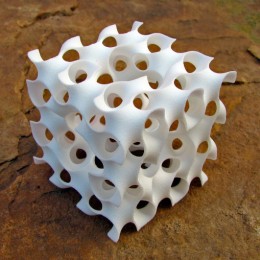 Some butterflies get their fabulous colors from light refracted through membrane shapes that were first discovered by mathematicians and applied in space-age material science. Using microscopes with three-dimensional nanoscale resolution, Yale University researchers found that shades of green in the wings of five butterfly species are produced by crystalline structures called gyroids.
Some butterflies get their fabulous colors from light refracted through membrane shapes that were first discovered by mathematicians and applied in space-age material science. Using microscopes with three-dimensional nanoscale resolution, Yale University researchers found that shades of green in the wings of five butterfly species are produced by crystalline structures called gyroids.
The gyroid shape was conceived in 1970 by NASA physicist Alan Schoen in his theoretical search for ultra-light, ultra-strong materials for use in space. The new study describing the shape in butterflies is in the June 15 Proceedings of the National Academy of Sciences.
Gyroids have what’s known as an “infinitely connected triply periodic minimal surface”: For a given set of boundaries, they have the smallest possible surface area. The principle can be illustrated in soap film on a wireframe. Unlike soap film, however, the planes of a gyroid’s surface never intersect. As mathematicians showed in the decades following Schoen’s discovery, gyroids also contain no straight lines, and can never be divided into symmetrical parts. Yet even as mathematicians speculated on the nature of gyroids, entomologists found them in nature, at least in two dimensions. Microscopic images of butterfly wings showed that the surface of some scales, and how those scales reflected light, matched the predictions of gyroid math.
From: Wired.com

 RSS FEED
RSS FEED FACEBOOK
FACEBOOK TWIITER
TWIITER TUMBLR
TUMBLR